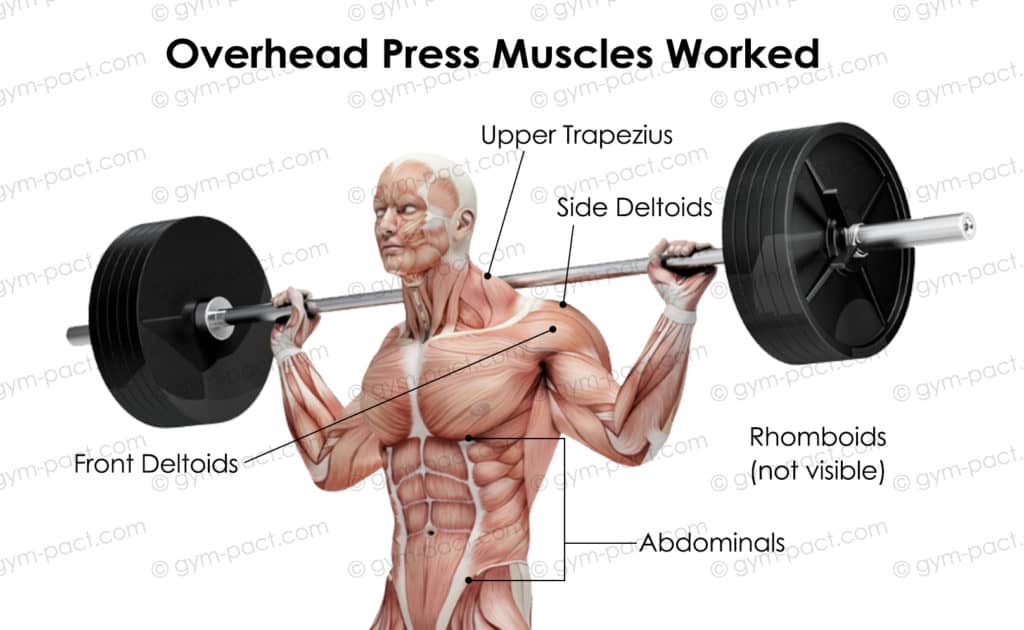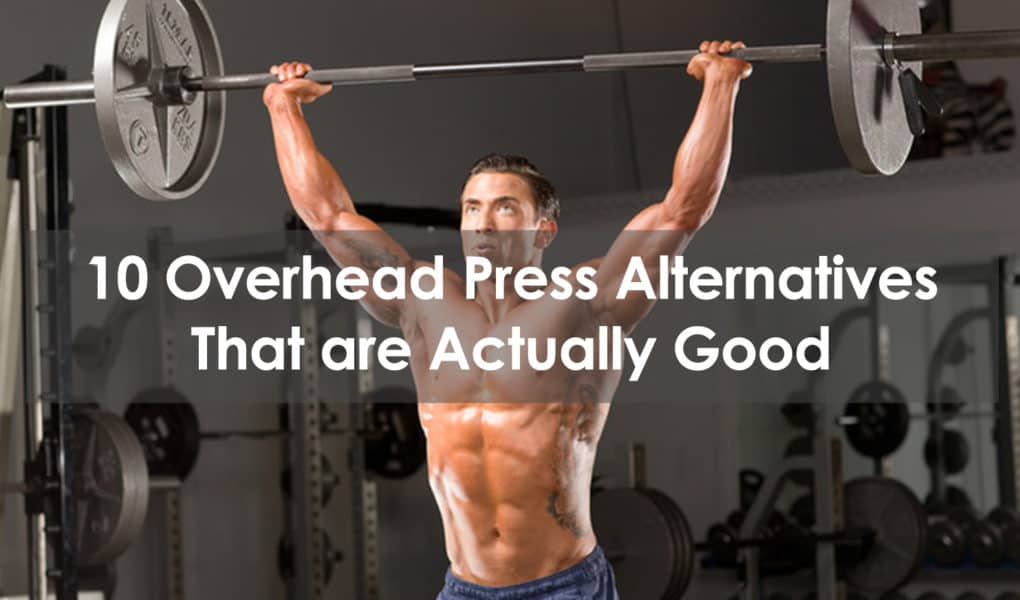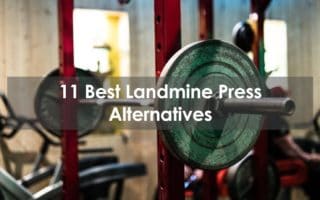The overhead press is a foundational compound free weight exercise that will get you bigger and stronger faster. To completely develop all three deltoid heads and promote complete upper body power, however, it’s a good idea to include a range of alternative exercises. In this article, we present 10 great overhead press alternatives.
Muscles Worked by the Overhead Press
The prime muscle movers when doing the overhead press are the front and side deltoids. There are three separate muscles (or heads) that make up the deltoids and this exercise works the two largest. This exercise will also provide secondary stress on the upper trapezius, rhomboids, and abdominals.

Benefits of the Overhead Press
1. Core Stability
When you are pushing a heavy weight overhead, you need to maintain a tight core for stability. As you progressively increase resistance, your core will become stronger and your balance of power will improve.
2. Shoulder Mass
The overhead press will make your shoulders wider and thicker.
3. Improved Bench
The stronger your front deltoids, the more weight you will be able to bench press, so the overhead press will indirectly improve your bench numbers.
10 Great Overhead Press Alternatives
1. Incline Cuban Press
Muscles Worked:
Posterior delts, trapezius, rotator cuff
Equipment Needed:
Dumbbells and an Incline bench
Why It’s a Great Alternative
The Incline Cuban press will strengthen the supporting muscles around the scapular and rotator cuff. These muscles are often overlooked by other exercises. Strengthening them will make you less prone to injury.
How to do it:
- Lie facedown on an incline bench with your palms turned back and holding dumbbells in your hands, hanging down but not quite touching the floor.
- Rise the elbows so that they are flared directly out to the sides of the body at a 90-degree angle.
- Leaving the elbows in place, rotate the back until the upper arm is parallel to the floor and forming a letter L that can be seen from above.
- Reverse the entire motion in a slow, controlled manner until you reach the starting point.
2. Muscle Clean
Muscles Worked:
Deltoids, trapezius, rhomboids
Equipment Needed:
Olympic barbell
Why It’s a Great Alternative
The muscle clean is an awesome power-building compound exercise that will allow you to push more weight on all other shoulder press alternatives. This compound push exercise will strengthen your entire upper body. It is a fundamental explosive movement.
How to do it:
- Stand erect, holding a barbell in an overhand grip and feet hip width apart.
- Pull the elbows up as you would for an upright row When near the top of the upright row, shoot the elbows down, under, and through the bar to catch the bar as you would for a hang clean.
- Reverse the action to return to the start position.
3. Military Press
Muscles Worked:
Front and side deltoids
Equipment Needed:
Bench, Olympic barbell
Why It’s a Great Alternative
The military press is a more shoulder joint-friendly version of the overhead barbell or dumbbell shoulder press.
How to do it:
- Sit on a bench with a barbell resting on your clavicles.
- Press the bar directly overhead until the elbows are locked.
- Lower and repeat.
Note: use a spotter to help you get the bar in the starting position.
4. Bradford Press
Muscles Worked:
Deltoids
Equipment Needed:
Olympic barbell
Why It’s a Great Alternative
The Bradford Press provides a fuller range of motion than the standard overhead press.
How to do it:
- Hold a barbell at chin level with an overhand shoulder-width grip. The elbows should be directly in front of the shoulders.
- Press the barbell up to the top of the head, then take the barbell over the top of the head, turning the elbows out slightly to help take the bar behind the head to the base of the skull.
- Slowly return to the start position.
5. Lateral Raise
Muscles Worked:
Side (lateral) deltoids
Equipment Needed:
Dumbbells
Why It’s a Great Alternative
The lateral raise is the best exercise you can do to target the lateral deltoid. It provides constant tension which you cannot get when you use dumbbells.
How to do it:
- Stand erect with a pair of dumbbells directly at your sides, holding the dumbbells in a neutral grip, and turning your palms toward your body.
- Keeping the arms nearly straight (slight bend in the elbows), raise the dumbbells straight out laterally until they reach at or just below shoulder level so the arms and body make a 90-degree angle on each side.
- Return to the starting position in a controlled manner.
6. Front Plate Raise
Muscles Worked:
Deltoids
Equipment Needed:
Weight plate
Why It’s a Great Alternative
The Front Plate Raise allows you to directly stress your front delts with a single plate movement. Keep your range of movement short to keep the intensity on the working muscle.
How to do it:
- Stand with a weight plate held at arm’s length with an overhand grip, palms facing the body.
- Keeping the arms nearly straight (slight bend in the elbows), raise the dumbbells straight up in front of you until they reach shoulder level.
- Return to the starting position under control. Maintain a neutral spine throughout the entire exercise.
7. Leapfrog Push Ups
Why it’s a great alternative
The leapfrog push up is a combination of muscle budding and explosive plyometric exercise. As such, it will help you to build strength and muscle through the delts and chest while also boosting your upper body’s explosive power output.
Muscles worked
Deltoids, chest
Equipment
None
Step by step how to
- Get down on all fours, with your palms and feet making contact with the floor. Bring your butt up to form an inverted V position. Your knees should be slightly bent and shands just outside of shoulder width.
- Bend your elbows to perform a push up, bringing your head to the floor.
- Explode out of the push up to lift your hands and feet into the air.
- Perform 3 sets of 8-10 reps.
Training Tips
Push your hands into the floor on the push up return as you propel your body into the air.
8. Push Ups with Dumbbells
Why it’s a great alternative
Doing push ups with dumbbells allows you to get a great chest extension on the negative part of the push up exercise. This provides greater stimulation of pec fibers than the standard version of the exercise.
Muscles worked
Pectorals
Equipment
2 x dumbbells
Step by step how to
- Get down on the floor with a pair of dumbbells in your hands. Assume the top push up position with the dumbbells on the floor at shoulder width.
- Lower down into the bottom push up position, descending lower than the level of your hands.
- Power back up to the start position.
- Perform 3 sets of 10 reps.
Training Tips
Take advantage of the extra height from the floor provided by the dumbbells by lowering as much as you can to get the maximum chest stretch.
9. Face Pull
Muscles Worked:
Trapezius, rhomboids
Equipment Needed:
Cable machine, rope attachment
Why It’s a Great Alternative
The Face Pull allows you to directly target the upper trapezius and the rhomboids, which add density and power to the area that surrounds your shoulders.
How to do it:
- Set the pulley on a cable pulley machine at eye level. Hold a rope attachment at arm’s length. Stand facing the machine with feet shoulder width apart.
- Drawing the elbows back, pulling the rope to your face in an overhead rowing manner. Bring your shoulder blades together as you pull back.
- Reverse the action to return to the start position.
10. Inverted Row
Muscles Worked:
Latissimus Dorsi, deltoids, trapezius
Equipment Needed:
Weight rack, barbell
Why It’s a Great Alternative
The inverted row is a great bodyweight exercise that moves your shoulder and lats through a full range of motion. You can increase the intensity of this bodyweight movement by getting your body lower to the floor.
How to do it:
- Lie faceup on the floor or on a bench with a weight rack. With an overhand grip, grasp a bar that is about 4 feet off the ground, or in the weight rack, with your hands shoulder-width apart. Your body should be rigid and in a straight line.
- Keeping the body rigid and the back in a neutral position, pull until the midline of the chest is in contact with the bar. Hold for 3 counts and then lower the body back to the starting position.
Conclusion
The overhead press deserves to be a foundational part of your upper body strength and mass training program. Use our alternative exercises to round out your shoulder routine and place more specific emphasis on the 3 deltoid heads. Choose two or three exercises and combine them into a deltoid blasting workout, doing four sets of each move, with reps ranging from 15 down to 6. Do this once per week in addition to regular overhead pressing and you will be well on your way to developing boulder shoulders.
Frequently Asked Questions
Is the overhead barbell press bad for your shoulders?
No, the overhead press is not bad for your shoulders, though it does put some strain on the infraspinatus. If you already have compromised shoulder joints or suffer from impingement syndrome, the overhead shoulder press may make the condition worse, compromising your shoulder health. Often pain that people feel while overhead pressing is due to a lack of shoulder mobility rather than an inherent problem with the exercise.
Is the overhead press enough for shoulders?
No, the overhead press is not enough for complete shoulder development. There are three heads to the deltoids; the front, side, and rear. The overhead press works two of them, those being the front and side muscles. So, for complete shoulder development, you also need to do exercises for the posterior deltoids, such as rear delt flyes.
Is it better to do the shoulder press in the standing or seated version?
The standing shoulder press is better than the seated position. The standing version requires greater balance, shoulder stability, and overall muscle recruitment and allows for a greater range of motion.







